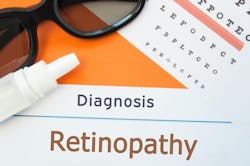Study Shows AI Eye Exams Improve Detection of Diabetes Eye Diseases
According to a Johns Hopkins Children’s Center study, autonomous artificial intelligence (AI) eye exams significantly increase completion rates of screenings that test for potentially blinding diabetes eye diseases (DED) compared to traditional methods.
These exams take pictures of the backs of the eyes “without the need to dilate them, and AI is used to provide an immediate result.” Traditionally, diabetes specialists and eye doctors recommend an annual screening for patients with diabetes which then typically require a separate visit to an eye care provider (like an optometrist or ophthalmologist) after the fact and the use of drops to dilate the pupil to achieve a clear view of the retina. Studies show that only 35% to 72% of youth with diabetes undergo recommended screenings, with higher care gap rates among minority and poor youth.
DED is an umbrella term that primarily refers to diabetic retinopathy, “a potentially blinding complication of diabetes that occurs when poorly controlled sugar levels cause the overgrowth of, or damage to, blood vessels and nerve tissues in the light-sensitive retina at the back of the eye.” According to the researchers, retinopathy affects 4% to 9% of youth with type 1 diabetes, and 4% to 15% of youth with type 2 diabetes. Frequent screenings for DED help prevent progression of DED through early detection and treatment.
Previous studies by Risa Wolf, M.D., a pediatric endocrinologist at Johns Hopkins Children’s Center, have already found that these AI screenings produce results that enable accurate DED diagnoses. In this new study, published Jan. 11 in Nature Communications, researchers enrolled 164 participants who ranged in age from 8 to 21 years between Nov. 24, 2021, and June 6, 2022. 58% of the participants were female and 41% were from minority groups; 47% of the participants had Medicaid insurance, as well. The first group, made up of 83 of the participants, received the standard screening instructions and care and were then referred to an optometrist or an ophthalmologist. The second group, comprising the remaining 81 participants, underwent a five-to-10 minute AI system diabetic eye exam during a visit to their endocrinologist, receiving their results at the same visit without the need for a follow-up with an eye care provider to interpret the findings. The AI system takes pictures of the eye without dilation, running the images through an algorithm that detects the presence of diabetic retinopathy. If present, the patient is referred to an eye doctor. If not, no next step is required until the next annual screening.
The study found that 100% of patients in the group offered the autonomous AI screening completed their eye exam that day, “while 22% of patients from the [first] group followed through within six months to complete an eye exam with an optometrist or ophthalmologist. The researchers found no statistical differences based on race, gender or socioeconomic status for whether participants in the [first] group scheduled the separate screening with an eye doctor.”
Wolf, the study author, emphasizes that “with AI technology, more people can get screened, which could then help identify more people who need follow-up evaluation.” Additionally, the researchers are hopeful that these AI exams can help close the care gap prevalent in traditional methods of screening by assuaging barriers to screening such as “confusion about the need for screenings, inconvenience, and lack of time.”
Study authors include the caveat that “autonomous AI used in their study is not approved by the U.S. Food and Drug Administration for those under 21 years old.” They also mention that “a potential source of bias in the study was that some of the participants were familiar with autonomous AI diabetic eye exams from a prior study, and therefore may have been more willing to participate in the new one.”
Johns Hopkins Medicine’s website has the article.

